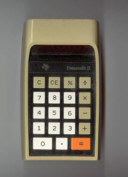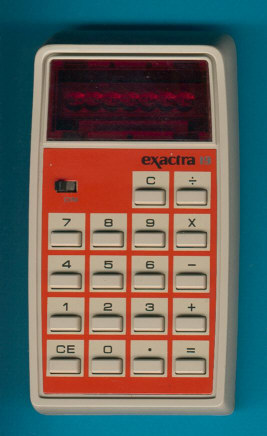
DATAMATH CALCULATOR MUSEUM
 |
DATAMATH CALCULATOR MUSEUM |
Exactra 19 by Texas Instruments
| Date of introduction: | October 1974 | Display technology: | LED-stick |
| New price: | $16.30 (The Ohio State Univ.) | Display size: | 6 + Sign |
| Size: | 5.1" x 2.9" x 1.3" 130 x 74 x 34 mm3 |
||
| Weight: | 5.1 ounces, 144 grams | Serial No: | 1900039332 |
| Batteries: | 3*AA Alkaline | Date of manufacture: | wk 44 year 1974 |
| AC-Adapter: | Origin of manufacture: | USA | |
| Precision: | 6 | Integrated circuits: | TMC0806, ITT 492 |
| Logic: | Chain | Displays: | DIS-EX19 |
| Memories: | |||
| Program steps: | Courtesy of: | Joerg Woerner | |
| Download manual: | |

![]()
 When
The Ohio State University approached Texas Instruments early in Summer 1974 with
the demand of Thousands of high quality calculators in the $15.00 to $20.00
range for a Classroom Experiment, they actually initiated the development of
this Exactra 19.
When
The Ohio State University approached Texas Instruments early in Summer 1974 with
the demand of Thousands of high quality calculators in the $15.00 to $20.00
range for a Classroom Experiment, they actually initiated the development of
this Exactra 19.
Texas Instruments established with the Exactra 20 already a
budget calculator with an SRP of $39.88 and the Exactra 19 was the result of a
dramatic cost-reduction program:
| • Smaller keys without injection molded lettering. • Drop of the sliding switch to use either fix point or floating point notation. • Replacement of the double-sided printed circuit board (PCB) with a single-sided PCB. • Replacement of the TMS0135 single-chip calculator circuit with more cost effective TMC0806. |
Texas Instruments obviously achieved their goals, the Exactra 19 was sold in the bookstores for $16.30 to the students of The Ohio State University.

 The manufacturing costs of the keyboard could be reduced by
dropping the double-shot injection molding process in favor of a simple-shot
process. Please notice the 6-digit display already known from the Exactra 20.
Did you notice the "bubble lens" to magnify the small
LED
(Light Emitting Diode) display? One of the most sought part of some Exactra calculators - don't miss the
Star Wars: Episode IV - A New Hope (1977)
story and learn more about the Exactra
Calculator LED Displays.
The manufacturing costs of the keyboard could be reduced by
dropping the double-shot injection molding process in favor of a simple-shot
process. Please notice the 6-digit display already known from the Exactra 20.
Did you notice the "bubble lens" to magnify the small
LED
(Light Emitting Diode) display? One of the most sought part of some Exactra calculators - don't miss the
Star Wars: Episode IV - A New Hope (1977)
story and learn more about the Exactra
Calculator LED Displays.
 The keyboard assembly still has an opening for the sliding
switch to select between fix point or floating point notation, but the switch itself is missing.
The keyboard assembly still has an opening for the sliding
switch to select between fix point or floating point notation, but the switch itself is missing.

 The
single-sided printed circuit board (PCB) of the Exactra 19 makes use of the TMC0806
single-chip calculator circuit and a
75492-style digit driver
manufactured by ITT. The remaining parts on the PCB form a small power-converter to generate the
VDD and VGG supplies of the TMC0806 chip with three AA-sized batteries.
The
single-sided printed circuit board (PCB) of the Exactra 19 makes use of the TMC0806
single-chip calculator circuit and a
75492-style digit driver
manufactured by ITT. The remaining parts on the PCB form a small power-converter to generate the
VDD and VGG supplies of the TMC0806 chip with three AA-sized batteries.
On our quest to Record the ROM Content of the TMC0806 single-chip calculator circuit, we looked into the power supply of the featured Exactra 19 calculator manufactured in October 1974 and measured voltages of VDD = -10.2 V and VGG = -16.0 V while operated with VBAT = 4.5 V. Clock frequency of the TMC0806 was measured with only 85 kHz and with just 6-digits to display, power consumption of the Exactra 19 is with 40 mA to 70 mA very low for an LED-based calculator.
 With
the DCM-50A Platform developed to
Characterize and
Reverse-engineer
Single-chip Calculator Circuits we could proof that the
Program Code of the
TMC0806 is tracing back to the
TMS0803 but uses only the seven
leftmost digit outputs for the sign and 6-digit number. The two remaining digits
output '00' but are not connected to the LED display of the calculator. An
interesting change could be found when outputting error messages, a division of
a positive or negative number by zero shows six '0' together with five decimal
points and 'C' in the leftmost position for 'C0.0.0.0.0.0. An overflow shows the
6 most significant digits of the result together with five decimal points and
'C' (or 'E' for negative numbers) in the leftmost position. And last but not
least as small bonus, the percentage function of the TMS0803 is present, despite
the Exactra 19 not featuring a [%] key.
With
the DCM-50A Platform developed to
Characterize and
Reverse-engineer
Single-chip Calculator Circuits we could proof that the
Program Code of the
TMC0806 is tracing back to the
TMS0803 but uses only the seven
leftmost digit outputs for the sign and 6-digit number. The two remaining digits
output '00' but are not connected to the LED display of the calculator. An
interesting change could be found when outputting error messages, a division of
a positive or negative number by zero shows six '0' together with five decimal
points and 'C' in the leftmost position for 'C0.0.0.0.0.0. An overflow shows the
6 most significant digits of the result together with five decimal points and
'C' (or 'E' for negative numbers) in the leftmost position. And last but not
least as small bonus, the percentage function of the TMS0803 is present, despite
the Exactra 19 not featuring a [%] key.
If you have additions to the above article please email: joerg@datamath.org.
© Joerg Woerner, December 5, 2001. No reprints without written permission.